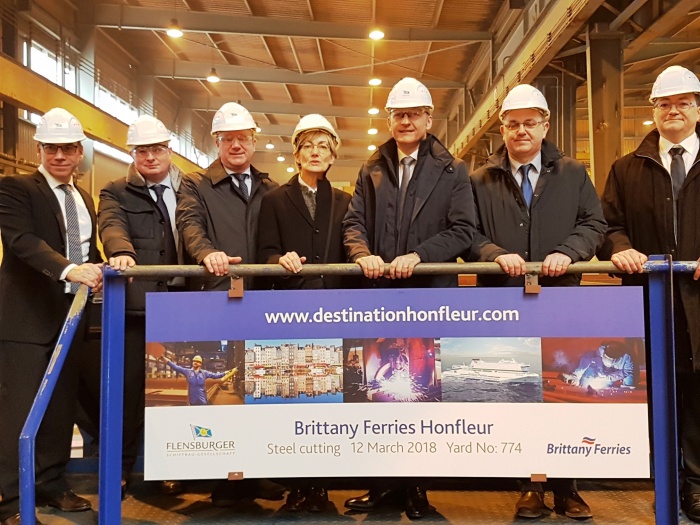
Brittany Ferries welcomes Honfleur steel cutting ceremony in Germany
White-hot plasma jets cut through sheets of steel at the FSG shipyard in Germany earlier.
The steel cutting ceremony marks the first step in the construction of Brittany Ferries’ Honfleur, a ship that will take little over a year to complete.
By June 2019, the metal being cut today will form part of a complex and complete 42,400 gross-tonne vessel, powered by liquefied natural gas, making her first crossing from Portsmouth to Caen.
“This is a very exciting day for everyone at Brittany Ferries,” commented Christophe Mathieu, Brittany Ferries chief executive, speaking from the yard.
“In little over one year, a mighty ship will rise, ready to carry passengers in comfort, style and on the cleanest vessel regularly operating on the Channel.
ADVERTISEMENT
“Today’s ceremony is like a glimpse into the future of sustainable ferry travel.
“It is a future that is not so far away for millions of holidaymakers and freight customers.”
Brittany Ferries will tell the story of the build through a new website.
Steel cutting, of course, is not the start of the process.
Before Honfleur is built in steel, she is built virtually.
Every other cut and weld has been carefully planned, along with the countless other operations required to build such a complex craft.
For shipbuilding in the 21st century is as much about CAD design, complexity management and logistics as it is about forming steel.
When complete, Honfleur will carry up to 1,680 passengers, 550 cars and 64 trailers and come with 261 cabins, two cinemas, restaurants, boutique shopping and expansive passenger lounges.
Wi-Fi will come as standard in all areas of the ship, including cabins and access from the car decks to passenger areas will be made as easy as possible for all passengers.
She will be the first ferry regularly operating on the English Channel, powered by liquefied natural gas.
This fuel emits less carbon dioxide during combustion than diesel and burns with no smoke.
It is entirely free of sulphur and produces very low emissions of nitrogen oxide and particulate matter.
Her dual fuel engines coupled with LNG-electric propulsion will bring further efficiency, as well as a smoother and quieter ride for passengers.
Overseeing the project is naval architect Brice Robinson, working on his fifth vessel for the company.
He is based in Germany with a team for the duration of the build.
“Building a ship is a little like cooking,” he summarised.
“It’s a recipe that requires the same quality ingredients, but you optimise the mix every time during its preparation.
“And with experience, you make it better and better.”

